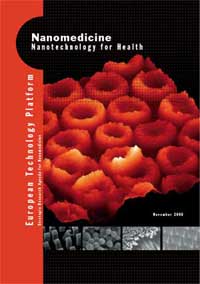| Posted: January 5, 2007 |
New report: Nanomedicine - Nanotechnology for Health |
|
(Nanowerk News) The European technology platform Nanomedicine published a 45-page vision paper – Nanomedicine - Nanotechnology for Health – on nanomedicine with the goal of defining the European nanomedicine research agenda for the next few years.
|
 |
|
Nanomedicine, the application of nanotechnology in healthcare, offers numerous very promising possibilities to significantly improve medical diagnosis and therapy, leading to an affordable higher quality of life for everyone. At the same time nanomedicine is a strategic issue for the sustainable competitiveness of Europe.
|
|
In order to avoid that this young and very fast growing discipline suffers from fragmentation and a lack of coordination, industry and academia – together with the European Commission – have identified the need for a European initiative to intermesh the several strands of nanomedicine into a firm strategy for advancement.
|
|
The resulting European Technology Platform on NanoMedicine is an industry-led consortium, bringing together the key European stakeholders in the sector.
|
|
In September 2005 it delivered a common vision of this technologically and structurally multi-faceted area 1, and defines the most important objectives in this Strategic Research Agenda (SRA).
|
|
The SRA addresses the Member States of the European Union, its Candidate Countries and Associated States to the EU Framework Programmes for research and tech no lo gi cal development, as well as the European Commission itself. Its main aim is to put forward a sound basis for decision making processes for policy makers and funding agencies, providing an overview of needs and challenges, existing technologies and future opportunities in nanomedicine. The SRA also takes into consideration education and training, ethical requirements, benefit/risk assessment, public acceptance, regulatory framework and intellectual property issues, thus representing a possible reference document for regulatory bodies.
|
|
The proposed disease oriented priority setting of this SRA is based on several parameters such as mortality rate, the level of suffering that an illness imposes on a patient, the burden put on society, the prevalence of the disease and the impact that nanotechnology might have to diagnose and overcome certain illnesses.
|
|
The scientific and technical approach is horizontal and exploits the benefits of interdisciplinarity and convergence of relevant technologies via breakthrough de ve lop ments in the areas of diagnosis, targeted delivery systems, and regenerative medicine.
|
|
The effective implementation of the SRA is expected to provide a major step forward in patient oriented affordable healthcare.
|

